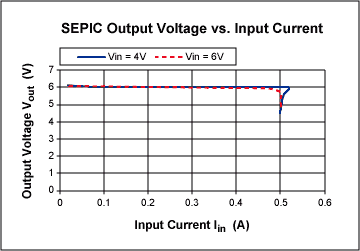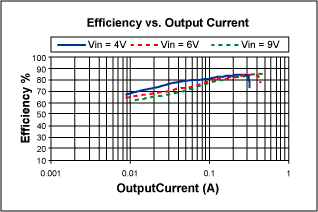

Current Limited DC-DC Controll
电源新闻
19人已加入
描述
Abstract: USB powered devices require a regulated supply. Unfortunately, the USB bus voltage can vary from 4V to 9V. Configuring the MAX668 boost controller into step-up/step-down topology can generate a current-limited regulated supply.
Universal Serial Bus (USB) is a popular way to connect PCs and consumer devices. It is simple and inexpensive and can connect multiple external peripherals simultaneously. As mobile devices add more functionality such as text messaging, web surfing, information storage and music playing, the need to communicate with a PC is increasing. Many of the mobile devices today offer a USB interface native in the device. The sole purpose is to provide a connection for data communication. The device may be self powered (e.g., through a wall adapter) or draw the power from the USB bus.
The mobile devices are typically expected to connect to a powered USB hub. A USB device can have its own power source (e.g. batteries or a wall plug) or draw the power from the USB bus. A powered USB host can provide up to 500mA current. Using the power supplied by USB can be tricky because the voltage to a USB powered device may be as low as 4.35V, when cable and connector drops are considered, or as high as 5.5V. If the device is to operate with a voltage adapter for a source it may see input voltages as high as 9V. In order to accommodate these various scenarios, a step-up/step-down DC-DC topology works well. The input and output specifications for a controller/converter are summarized in Table 1.
Table 1. Power Supply Requirements for USB Compatible Portable Device

Figure 1. SEPIC power supply for USB compatible device.
The current limit resistor R4 (Figure 1) is used to limit the input current to a maximum of 500mA as specified in Table 1. The input current limit also ensures short-circuit protection ensuring USB compliance even under output fault conditions. When the output exceeds the input current limit the output voltage will reduce and restrict the input current to 500mA as shown in Figure 2. Note the extra inductor required in this topology as compared to a regular boost topology.

Figure 2. Input current limiting using MAX668 SEPIC.
The use of a coupled inductor (two inductors wound on the same core) such as the Coiltronics CTX10-3 (Figure 1) reduces the leakage inductance. This makes it possible to achieve efficiencies of up to 85% in practice. Efficiency for this SEPIC converter is shown in Figure 3.

Figure 3. Efficiency of the MAX668 SEPIC.
打开APP阅读更多精彩内容
Universal Serial Bus (USB) is a popular way to connect PCs and consumer devices. It is simple and inexpensive and can connect multiple external peripherals simultaneously. As mobile devices add more functionality such as text messaging, web surfing, information storage and music playing, the need to communicate with a PC is increasing. Many of the mobile devices today offer a USB interface native in the device. The sole purpose is to provide a connection for data communication. The device may be self powered (e.g., through a wall adapter) or draw the power from the USB bus.
The mobile devices are typically expected to connect to a powered USB hub. A USB device can have its own power source (e.g. batteries or a wall plug) or draw the power from the USB bus. A powered USB host can provide up to 500mA current. Using the power supplied by USB can be tricky because the voltage to a USB powered device may be as low as 4.35V, when cable and connector drops are considered, or as high as 5.5V. If the device is to operate with a voltage adapter for a source it may see input voltages as high as 9V. In order to accommodate these various scenarios, a step-up/step-down DC-DC topology works well. The input and output specifications for a controller/converter are summarized in Table 1.
Table 1. Power Supply Requirements for USB Compatible Portable Device
| Parameter | Requirement |
| Input Voltage VIN | 4V to 9V |
| Input Current IIN | 500mA (±5%) max. |
| Output Power POUT | 2.4W typical |
| Output Voltage VOUT | 6V (±5%) typical |
| Output Load Current IOUT | 400mA max. |
| Regulation | Min. VOUT =5.5V at IOUT = 200mA |
SEPIC to 6V with Input Current Limiting
This step-up/step-down supply is used to power a Li+ battery charger. Since the charger itself will have a drop in voltage across it, the output voltage was set to 6V. The single-ended primary inductance converter shown in Figure 1 is ideal for this application. This buck-boost topology is needed since the input voltage can vary from values below the output voltage to values greater than the output voltage (Table 1). The MAX668 boost controller is adapted to SEPIC topology (Figure 1).
Figure 1. SEPIC power supply for USB compatible device.
The current limit resistor R4 (Figure 1) is used to limit the input current to a maximum of 500mA as specified in Table 1. The input current limit also ensures short-circuit protection ensuring USB compliance even under output fault conditions. When the output exceeds the input current limit the output voltage will reduce and restrict the input current to 500mA as shown in Figure 2. Note the extra inductor required in this topology as compared to a regular boost topology.

Figure 2. Input current limiting using MAX668 SEPIC.
The use of a coupled inductor (two inductors wound on the same core) such as the Coiltronics CTX10-3 (Figure 1) reduces the leakage inductance. This makes it possible to achieve efficiencies of up to 85% in practice. Efficiency for this SEPIC converter is shown in Figure 3.

Figure 3. Efficiency of the MAX668 SEPIC.
声明:本文内容及配图由入驻作者撰写或者入驻合作网站授权转载。文章观点仅代表作者本人,不代表电子发烧友网立场。文章及其配图仅供工程师学习之用,如有内容侵权或者其他违规问题,请联系本站处理。
举报投诉
- 相关推荐
- current
-
#电机驱动 Current mode DC-DC和DCAP2 mode DC-DC设计实例电子技术那些事儿 2022-09-12
-
#2022慕尼黑华南电子展 #DC-DC电源 3.7V- 600V输入 输出0-600VCBY电子 2023-03-07
-
DC-DC典型设计应用2009-10-30 0
-
DC-DC基础入门教程 Advanced DC-DC Converters2009-10-31 0
-
DC-DC典型应用2009-11-14 0
-
DC-DC模块2011-09-15 0
-
DC-DC工作原理2012-08-29 0
-
无线充电 DC-DC 芯片2015-12-17 0
-
MPS DC-DC Designer如何搞定DC-DC电路设计?2021-03-11 0
-
DC-DC电源的相关资料分享2021-11-17 0
-
DC-DC与电感的相关资料分享2021-11-17 0
-
Buck型DC-DC的相关资料分享2021-11-17 0
-
LDO和DC-DC有什么不同?2021-11-17 0
-
什么是DC-DC2021-11-17 0
-
DC-DC,看这篇文章就够了2021-11-09 642
全部0条评论

快来发表一下你的评论吧 !

